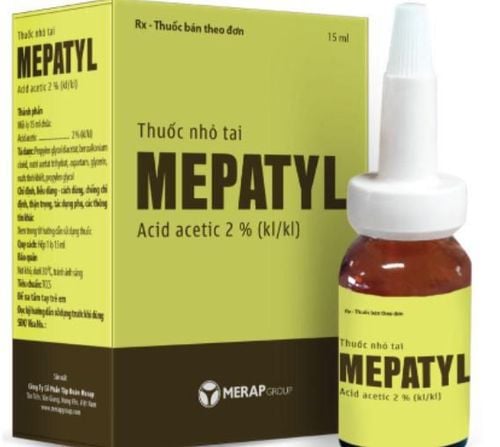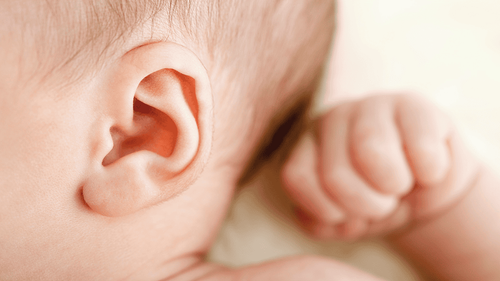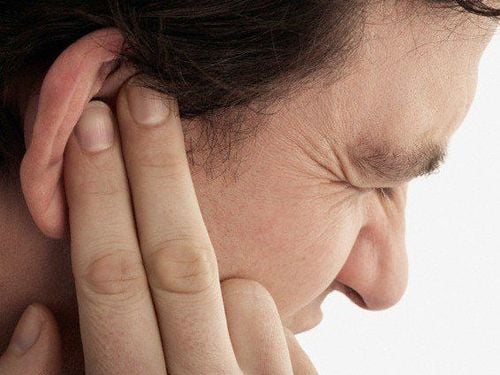This is an automatically translated article.
The article is expertly consulted by Master, Doctor Truong Thanh Tam - Pediatrician - Pediatrics - Neonatology - Vinmec Danang International General Hospital. Dr. Tam has 15 years of experience working in the field of Pediatrics.Ear infections in babies and young children are very common, especially after a cold or flu. Signs of an ear infection include fussiness, ear pain, fever, and loss of appetite.
1. What is an ear infection?
An ear infection, also known as otitis media, is an ear infection that involves inflammation or infection of the middle ear (a small air-filled sac behind the eardrum).Ear infections in babies and young children are very common, especially after a cold or flu. Signs of an ear infection include fussiness, ear pain, fever, and loss of appetite. However, most children get better within a few days with rest, plenty of fluids, and over-the-counter pain relievers (if recommended by their doctor). But if your child is 6 months or younger, has symptoms in both ears, or has serious symptoms such as a fever higher than 39 degrees Celsius, you need to see a doctor and it is likely that he or she needs treatment. with antibiotics.
There are a number of different otitis media, but the most common in infants and children is acute otitis media (AOM). With this type of ear infection, fluid becomes trapped behind the eardrum, and parts of the middle ear become infected and swollen. This causes the ear to hurt and the child may also have a fever.
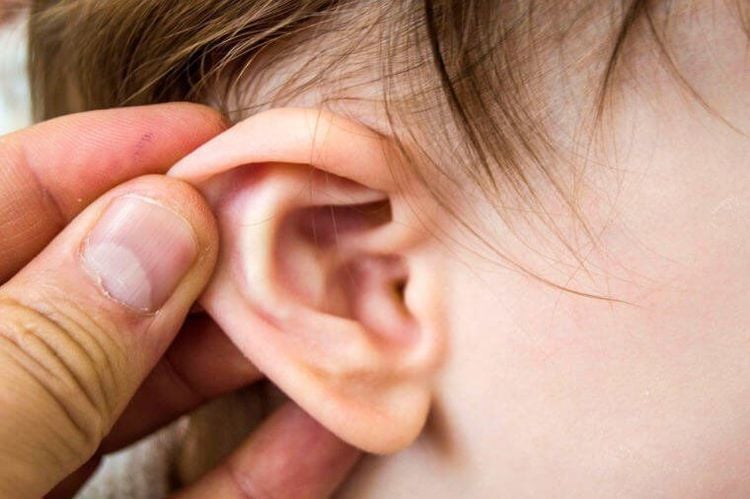
2. What causes ear infections?
Middle ear infections can be caused by bacteria or viruses. After an illness like a cold or the flu, fluid can build up in the middle ear, allowing bacteria or viruses to travel to the area to multiply and cause an infection.Normally, any fluid that enters this area quickly drains through the tympanic tube, which connects the middle ear to the back of the nose and throat. But if the tube is blocked — as often happens with colds, sinus infections (sinusitis), and even allergies — then fluid gets trapped in the middle ear.
Germs like to grow in dark, warm and humid places, so the fluid-filled middle ear is the perfect breeding ground. As the infection gets worse, the inflammation in and behind the eardrum also tends to get worse, making the pain worse. Children can also develop a fever as their body fights the infection.
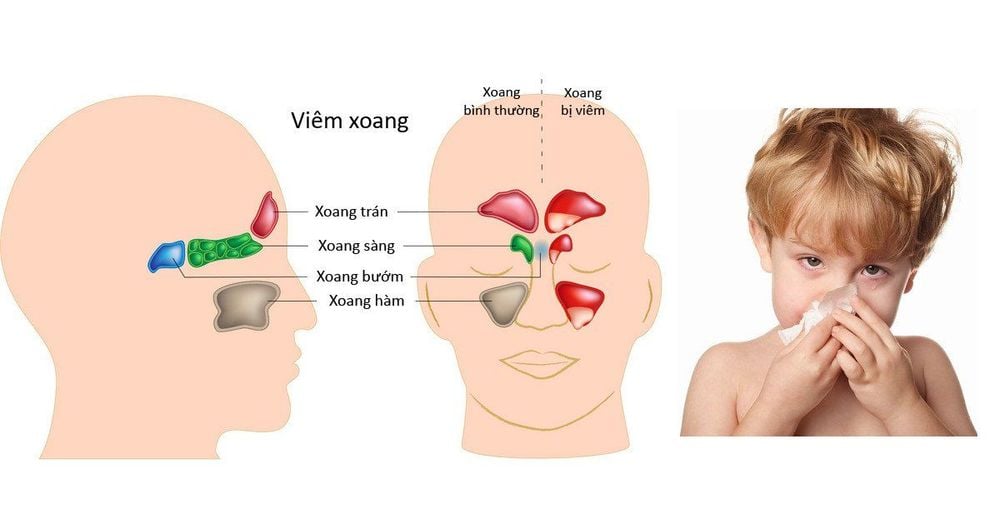
Trắc nghiệm: Sự phát triển tinh thần, vận động của bé thế nào là đúng chuẩn?
Khi nào bé biết nói, biết hóng chuyện hay biết cầm cốc là "đúng chuẩn"? Điểm xem bạn biết được bao nhiêu mốc phát triển tinh thần, vận động "đúng chuẩn" của bé nhé!The following content is prepared under supervision of Thạc sĩ, Bác sĩ y khoa, Ma Văn Thấm , Nhi , Phòng khám Đa khoa Quốc tế Vinmec Dương Đông(Phú Quốc)
Using a pacifier can increase the risk of middle ear infections. In one study, the rate of ear infections was 33% lower in children who did not use a pacifier.
Newborns are more susceptible to ear infections because they have short horizontal tubes (about 1/2 inch). As children grow into adulthood, their tubes triple in length and become more vertical, allowing fluid to drain more easily.
3. Signs of an ear infection in babies and children
The easiest way to tell if your child may have an ear infection (or any other illness associated with the condition) is to observe his or her mood swings.If your baby is fussy or starts crying more than usual, If your child has a fever (whether mild or high), these are also signs of an ear infection. Ear infections tend to happen after a child has a cold or a sinus infection, so you need to be aware of these.
In addition, children with ear infections often show the following signs:
Pull, grasp or tug at the ear: This can be a sign that the child is in pain. (Babies pull their ears for many other reasons, so if your baby seems fine, he probably doesn't have an ear infection.) Diarrhea or vomiting: the cause of an ear infection can also affect it. gastrointestinal. Decreased appetite: Ear infections can cause gastrointestinal upset. They can also make it difficult for your baby to swallow and chew. If your baby has an ear infection, he may withdraw from the breast or bottle after the first few sips. Yellow or white discharge from the ear: This doesn't happen to most babies, but it's a sure sign of an infection. It also signals that a small hole has developed in the eardrum. (Don't worry - this will heal once the infection is done.) Bad smell: You may smell a foul odor coming from your child's ears. Difficulty sleeping: Lying down can make it more painful for a child with an ear infection. Fever: the child may have a fever above 39 degrees C
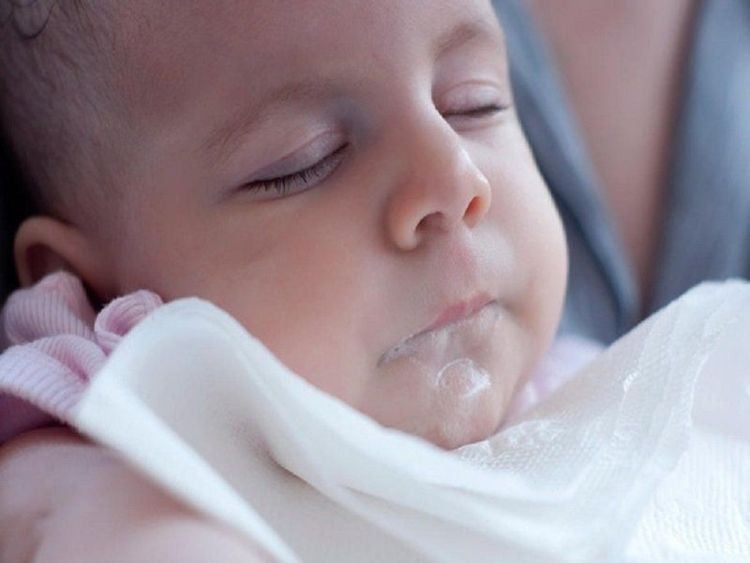
In addition to the above symptoms, you may notice some other symptoms in your child when you have an ear infection, including:
Headache: Pain from the ear may spread to the head. Difficulty hearing sounds: Fluid buildup in the middle ear can prevent you from hearing other sounds. Difficulty with balance: Ears help with balance, so you may notice that your child seems a little wobbly with an ear infection.
4. How common are ear infections in children?
Ear infections are one of the most commonly diagnosed childhood illnesses in the United States. One study conducted showed that 23% of infants had at least one ear infection by the time they were 1 year old, and more than half had at least one ear infection by the age of 3.5. Treatment of ear infections in infants and children
Treatment for an ear infection depends on the severity of the infection and the child's age. Newborns 6 months and younger and very sick children may need to be treated with antibiotics. For most other cases, doctors recommend waiting and seeing your doctor within 2-3 days, as ear infections usually go away on their own. About 80% of children with AOM recover without antibiotics.For years, antibiotics were considered the first line of defense against ear infections, but now doctors are prescribing them more cautiously. Taking antibiotics too often is a concern because it can make children more susceptible to antibiotic-resistant infections.
Consult your doctor to see if your child's condition already requires antibiotics. In addition to antibiotics, the doctor may recommend the following treatment:
If your child is 6 to 24 months old and has only mild symptoms in one ear, or if the child develops mild symptoms affects one or both ears, monitor the child's condition first. Your doctor may also prescribe an over-the-counter pain reliever to help make your child more comfortable. If your child's condition does not improve in 48 to 72 hours, see your doctor, who may consider starting antibiotics.

Newborns 6 months and younger; Newborns don't have mature immune systems and are especially susceptible to complications from AOM. Children 6 months and older with severe symptoms, such as a fever higher than 39 degrees Celsius or moderate to severe ear pain that lasts for at least 48 hours. Children 6 to 24 months of age with AOM that affects both ears (even if there are no severe symptoms). If your child needs antibiotics, give them the full course, even if they feel better. Then, check your ears again in a few weeks so your doctor can make sure the medicine is working.
If your child's condition does not improve after 48 to 72 hours of antibiotics, let the doctor know. Your doctor may prescribe another medicine for your child.
6. Why are doctors concerned about prescribing antibiotics to children with ear infections?
Doctors are often cautious about prescribing antibiotics because more and more bacteria are resistant to them. And besides helping fight antibiotic resistance, giving kids antibiotics also kills the good bacteria, which are essential for keeping the digestive tract healthy.Also, ear infections can be caused by bacteria or viruses. Because antibiotics don't work against infections caused by viruses, doctors are extra cautious when prescribing them.
Pharmaceutical companies used to be one step ahead by constantly introducing new drugs, but bacteria mutated rapidly in response, making the drugs less effective. Doctors say parents can help combat this problem by not requiring antibiotics for every time a child has an ear infection or the common cold.
You should contact your doctor when your child shows the first signs of an ear infection. If the doctor asks you to come in, he or she may need to look at your child's ears with an otoscope. Red, bulging, and draining eardrums can be signs of an infected ear.
The doctor may also check to see if the eardrum has moved in response to a device called a pneumatic otoscope, which releases a brief stream of air into the ear. If it doesn't move, that's another sign that fluid is building up in the middle ear and possibly getting an infection.
Whether the treatment is wait-and-see or antibiotics, your child's condition will improve every day. If your child's condition does not get better after 48 to 72 hours, let the doctor know. You should have your child return for a follow-up visit and start an antibiotic, or change the antibiotic if your child has been on it before.
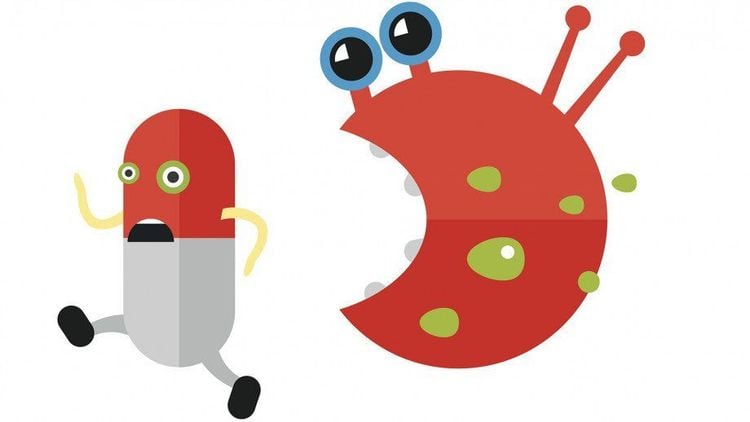
7. Remedies for ear infections
Here are some ways to help your child feel better when he or she has an ear infection:Pain relievers. It is important to use the correct dose when giving infant acetaminophen or ibuprofen (only give ibuprofen if your baby is 6 months or older) to help relieve pain. If your child is less than 3 months old, ask your doctor before giving any medicine to your child. Warm compress. Keep a warm compress and place it gently on your child's ear to help relieve pain. Drink plenty of water Encourage your child to drink more water, as swallowing helps drain fluid from the middle ear and relieve painful pressure. If you have young children, breastfeed or bottle-feed them more often. Encourage your toddler or older child to sip water throughout the day. Here's what not to do when your child has an ear infection:
If your child is 3 years old or younger, DO NOT give them over-the-counter (OTC) cough and cold medicines such as decongestants or antihistamines. Not only do these drugs not help your baby get better, but they can also cause dangerous side effects for young children. (The AAP does not recommend OTC cough and cold medicines for children younger than 6 years old, although some doctors may recommend them for children 4 and 5 years old. You follow your doctor's advice.) No Never give aspirin to a child because it makes them more susceptible to Reye's syndrome, a rare but potentially fatal illness.

8. How to prevent ear infections in babies and children
Here are steps you can take to reduce your child's risk of recurrent ear infections.Breastfeed your baby for at least six months. Breast milk provides antibodies against ear infections. A large study published in the journal Pediatrics has shown that children who are breastfed for the first 6 months of life are less likely to develop ear infections than children who are not breastfed. Hold the baby upright while feeding. Hold the baby so that the head is higher than the rest of the body. Infants who are breastfed while lying down are more likely to have AOM. Get rid of pacifiers and don't use pacifiers if your baby is prone to ear infections. Babies 6 months and older are more likely to get ear infections if they use a pacifier. But because using a pacifier for the first year can help protect against SIDS, ask your specialist about the best time to wean. Wash your hands often. Although ear infections are not contagious, respiratory infections can lead to ear infections. Keep your child's hands clean and away from people with respiratory infections whenever possible. Make sure your child is fully immunized: Immunizations help prevent some diseases that can lead to ear infections. For example, the pneumococcal conjugate vaccine has significantly reduced the number of ear infections in children. Research shows that since the pneumococcal conjugate vaccine is included in the immunization schedule, the number of 3-year-olds with at least one ear infection has decreased by 20%. If your child has repeated ear infections, especially after having the flu, talk to his doctor about getting his or her annual flu shot. (Only children 6 months and older should get the flu shot.)

9. Can ear canal surgery help cure recurrent ear infections?
Ability. Doctors are divided on whether ear canal surgery is recommended in cases of recurrent ear infections because there are not many studies on their effectiveness and the available data are inconclusive. According to the AAP, "A growing number of better-controlled studies of ear canal surgery will help determine its benefits and harms."If your child's doctor recommends ear canal surgery, you will be informed about the pros and cons of the procedure. Your doctor may recommend this treatment if your baby is:
At least 6 months old Has hearing problems or has delayed speech due to an ear infection Fluid is present behind the eardrum for a long time No longer responding Response to antibiotic therapy According to the AAP, ear canals can be applied to infants (at least 6 months of age) and children who have had three recurrent episodes of AOM in six months, or four episodes in a year with recent episodes. This most happened in the past six months .
The procedure to perform ear canal surgery is as follows:
The child is taken to the operating room and given general anesthesia. An otolaryngologist (otolaryngologist) makes a small incision in the eardrum and sucks the fluid out. The doctor inserts a small tube into the slit. The tube releases pressure and acts as a vent, letting air in and liquid out, so bacteria can't multiply. The child will wake up in the recovery room.

Complications from anesthesia; Bleed; Infection; The tubes can sometimes fall out on their own; Increased risk of eardrum damage. Ear infections in young children and infants can be severe or, if left untreated, can rupture a child's eardrum. Tears don't happen often and usually heal quickly, but it's important to follow up with your doctor to make sure the infection is gone and the eardrum is healing.
Repeated ear infections can sometimes cause hearing loss and scarring. And in very rare cases, untreated ear infections can lead to mastoiditis (infection of the skull behind the ear) or meningitis.
As soon as your baby has symptoms of otitis media, you should take your child to see a specialist soon for timely examination and treatment advice. As a key area of Vinmec Health System, Pediatrics Department - Vinmec International General Hospital always brings satisfaction to customers and is highly appreciated by industry experts thanks to the following advantages:
Gathering a team of leading doctors and nurses in pediatrics: including leading experts, highly qualified (professors, associate professors, doctorates, masters), experienced, worked in hospitals as big as Bach Mai, 108.. The doctors are all well-trained, professional, have a mind - range, and understand young psychology. In addition to domestic pediatric specialists, the Department of Pediatrics also has the participation of foreign experts (Japan, Singapore, Australia, USA) who are always pioneers in applying the latest and most effective treatment regimens. . Comprehensive services: In the field of Pediatrics, Vinmec provides a series of continuous medical examination and treatment services from Newborn to Pediatric and Vaccine,... according to international standards to help parents take care of their baby's health from birth to childhood. from birth to adulthood Specialized techniques: Vinmec has successfully deployed many specialized techniques to make the treatment of difficult diseases in Pediatrics more effective: neurosurgery - skull surgery, stem cell transplantation. blood in cancer treatment. Professional care: In addition to understanding children's psychology, Vinmec also pays special attention to the children's play space, helping them to have fun and get used to the hospital's environment, cooperate in treatment, improve the efficiency of medical treatment.
Reference source: babycenter.com
Recommended video:
Does otitis media affect the baby?







